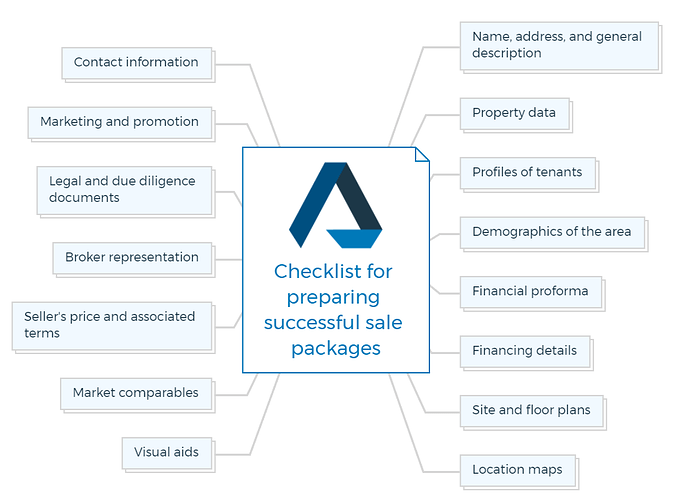1. Name, address, and general description
- To prepare a sales package outline, start by adding the property name.
- Include the full address, including the zip code.
- Describe the property’s unique features, architectural style, and stand out characteristics.
2. Property data
- Property Size: Specify the exact land and building square footage or acreage.
- Year Built and Renovation History: Note the year of construction and any significant renovations or upgrades made over the years.
- Condition of the Property: Provide an assessment of the property’s condition, including any recent maintenance or repairs.
- Environmental Reports: If environmental assessments have been conducted, summarize the findings and any mitigation measures taken.
- Existing Liens or Encumbrances: Clearly list any existing liens, mortgages, or encumbrances on the property.
3. Profiles of tenants
- List of current tenants: Include tenant names, types of businesses (for commercial properties), and lease start and end dates.
- Lease terms: Detail lease terms, including rental rates, security deposits, and any special provisions.
- Tenant payment history: Include a summary of rent payment histories and any arrears.
- Tenant contact information: Provide contact details for each tenant, including phone numbers and email addresses.
You are missing out if you haven’t yet subscribed to our YouTube channel.
4. Demographics of the area
- Population trends: Highlight population growth or decline trends in the area.
- Income levels: Include median household income statistics for the neighborhood or region.
- Employment opportunities: Mention major employers in the vicinity and industries driving job growth.
- Crime rates: Include relevant crime statistics or information about neighborhood safety.
- Schools and educational facilities: Detail the proximity and quality of nearby schools and educational institutions.
- Nearby amenities: List nearby shopping centers, parks, public transportation options, and other amenities.
5. Financial proforma
- Historical financial statements: Present several years of historical income statements and balance sheets.
- Projections for future income and expenses: Provide a clear breakdown of anticipated income and expenses over the next few years.
- Net operating income (NOI) calculation: Explain how NOI is calculated and provide the actual figures.
- Capitalization rate (Cap rate): Justify the chosen cap rate based on market conditions and comparable sales.
- Cash flow analysis: Include a cash flow statement showing net cash flows, including debt service.
6. Financing details
- Existing mortgages or loans: Specify the current loan amounts, interest rates, and remaining terms.
- Interest rates and terms: Provide details on loan terms, interest rates, and any adjustable-rate provisions.
- Loan amortization schedules: Include schedules showing principal and interest payments over time.
- Prepayment penalties: Disclose any penalties or fees associated with early loan payoff.
7. Site and floor plans
- Site plan: Include a detailed site plan showing property boundaries, buildings, parking areas, and landscaping.
- Floor plans: Attach floor plans for each building, indicating room dimensions and usage.
8. Location maps
- Property location: Highlight the property’s location on a city or regional map.
- Proximity to transportation: Indicate the distance to major highways, public transit, airports, and ports.
- Geographic features: Note any natural features that enhance the property’s appeal.
9. Visual aids
- High-quality photographs: Include high-resolution photos showcasing the property’s exterior, interior, and key features.
- Aerial photos: Provide aerial shots to give a comprehensive view of the property and its surroundings.
- 3D renderings: If available, include 3D renderings or virtual walkthroughs for a more immersive experience.
- Virtual tour links: Offer links to virtual tours for remote property exploration.
10. Market comparables
- Recent sales: List comparable properties that have sold recently, including sale prices, square footage, and proximity.
- Price per square foot analysis: Calculate the price per square foot of the subject property and comparable sales.
- Market trends and statistics: Include data on market trends, vacancy rates, and rental rate trends.
- Competitor analysis: Identify competing properties and highlight the subject property’s advantages.
11. Seller’s price and associated terms
- Sale price: Clearly state the asking price and any negotiation flexibility.
- Terms of sale: Outline the terms, including financing options, contingencies, and timelines.
- Inclusions and exclusions: Specify what is included in the sale (e.g., fixtures, appliances) and what is excluded.
12. Broker representation
- Contact information: Provide the listing broker’s contact details, including name, phone number, and email.
- Broker’s commission structure: Explain the commission structure and any incentives for cooperating brokers.
- Exclusive agreements: Mention any exclusive listing agreements or terms that may impact the sale process.
13. Legal and due diligence documents
- Title deed: Include a copy of the title deed and information on title insurance.
- Survey reports: Attach recent property surveys and boundary descriptions.
- Property disclosure statements: Include any legally required property disclosure statements or disclaimers.
- Inspection reports: Summarize any recent inspection reports, including repairs made in response.
- Legal agreements: Provide copies of relevant legal agreements, such as easements or restrictive covenants.
Learn More
14. Marketing and promotion
- Marketing plan: Describe the marketing strategy, target audience, and promotional activities planned.
- Advertising materials: Include samples of brochures, flyers, and online advertisements.
- Online listings: Provide links to online listings on the MLS (Multiple Listing Service) and other real estate websites.
- Open house schedule: Announce dates and times for open houses, property tours, or private showings.
15. Contact information
- Key personnel: List contact details for key individuals involved in the sale, including sellers, brokers, attorneys, and property managers.
- Emergency contact information: Provide emergency contact information for immediate assistance during the sales process.



